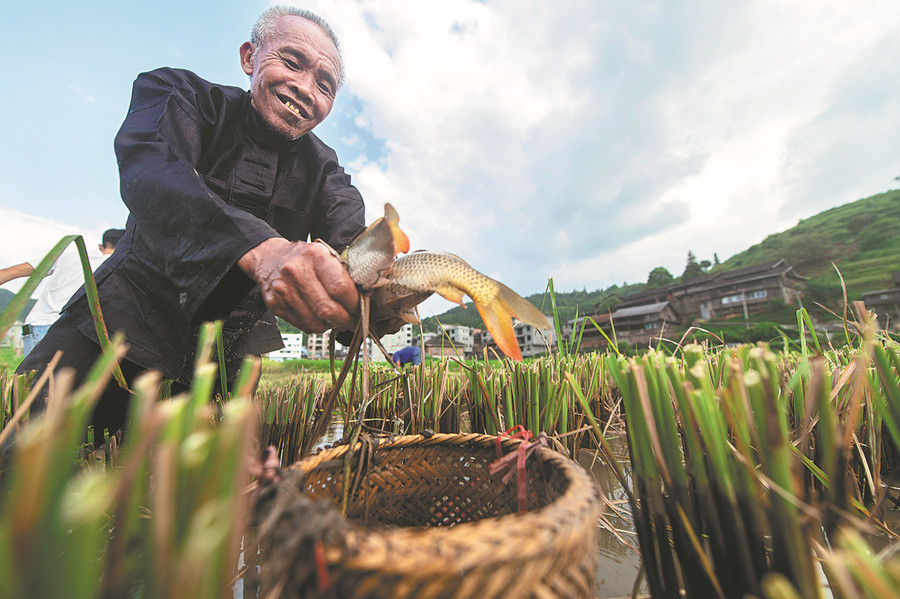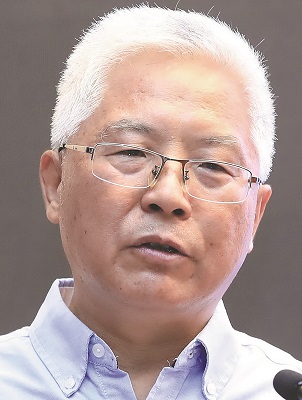Nation plays leading role in evaluation of global agricultural heritage sites

A farmer puts carp into a duck cage in a rice field in Congjiang, Guizhou province, last year. The county's rice-fish-duck farming model was listed as a Globally Important Agricultural Heritage System in 2011. [Photo by Wu Dejun/For China Daily]
As an early participant and firm supporter of global agricultural heritage systems, China — with its long history of creating environment-friendly farming models — has played a leading role in offering scientific and technological evaluation of such heritage, according to an expert.
"Modern farmers should not only consider improving chemical fertilizers, pesticides and equipment, but also consider adapting to climate change and determining how to meet the various needs of consumers," said Min Qingwen, a member of the Chinese People's Political Consultative Conference (CPPCC) National Committee and professor at the Chinese Academy of Sciences' Institute of Geographic Sciences and Natural Resources Research.
"Over the past 1,300 years, the Chinese people have created environment-friendly agricultural models that combine planting and aquaculture," said Min, a member of the 14th CPPCC National Committee.
China is home to 19 Globally Important Agricultural Heritage Systems sites, which are agroecosystems inhabited by communities that have an intricate relationship with their land, according to the Food and Agriculture Organization of the United Nations.
These evolving sites are resilient systems characterized by remarkable agro-biodiversity, traditional knowledge, invaluable cultures and landscapes, and are sustainably managed by farmers, herders and forest workers in ways that contribute to their livelihoods and food security.
The Ministry of Agriculture and Rural Affairs has identified 138 Nationally Important Agricultural Heritage Systems sites.
These sites, including the rice-fish co-culture system in Qingtian, Zhejiang province, and the Honghe Hani rice terraces in Yunnan province, are distributed in 13 provincial-level regions. In 2005, the Qingtian rice-fish co-culture system became the world's first GIAHS site.

Min Qingwen
As a new type of heritage, agricultural heritage not only has important historical value, but also promotes the sustainable development of agriculture in rural areas, Min said.
"The Qingtian rice-fish co-culture system ensures food security, boosts incomes, prevents malaria by reducing the number of mosquitoes and conserves biodiversity by reducing the use of pesticides," he said. "The people there use rice fields to raise fish that in turn promote rice growth.
"The combination greatly reduces chemical fertilizers and pesticides."
The heritage also promotes leisure agriculture and rural tourism so that farmers are more willing to preserve it, he added.
With its agricultural heritage brand, millet from Aohan Banner in the Inner Mongolia autonomous region, has gained a better reputation and more popularity, bringing in more income for farmers, he said.
"China has a long history of farming culture, and its people have created a large number of agricultural models. The nation is willing to share its wisdom," Min said. "China has also exported important species, technologies and cultures to other countries."
In 1998, the Chinese government donated a pair of crested ibis to Sado's Satoyama in Harmony with the Japanese Crested Ibis site, one of the first two GIAHS sites in Japan.
China's Ministry of Agriculture and Rural Affairs has organized more than 10 international training courses, and Chinese scientists have shared China's GIAHS research results and conservation experience.
In 2013, Min initiated the East Asia Research Association for Agricultural Heritage Systems, aiming to share research results and conservation experiences among China, Japan and South Korea.
"We plan to expand the exchange and collaboration platform to countries in South and Southeast Asia," he said.
Copyright © The National Committee of the Chinese People's Political Consultative Conference.
All rights reserved. Presented by China Daily.
京ICP备08100501号-1

